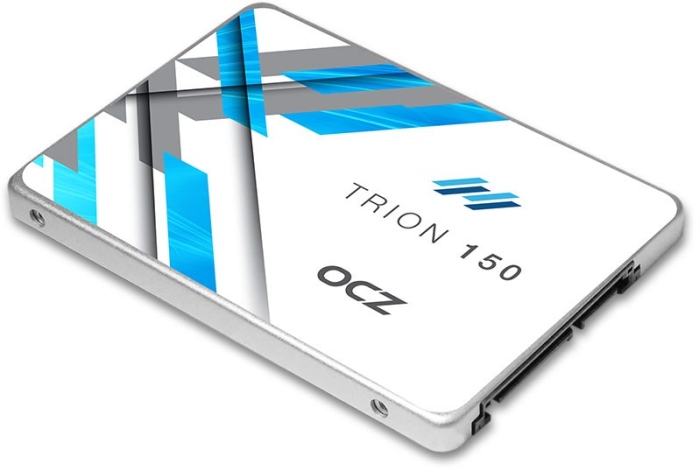Index
- OCZ Trion 150 480GB SSD Reviewed
- Performance Specifications
- Packaging
- Testing Methodology
- Benchmark Results - CrystalDiskMark x64 v5.1.2
- Benchmark Results - ATTO Disk Benchmark v3.05
- Benchmark Results – Iometer v1.1.0
- Benchmark Results – AS SSD Benchmark v.1.8.5636.37293
- Benchmark Results – PlayStation 4 SSD vs HDD
- Price-per-Gigabyte Comparison (March 28, 2016)
- Conclusion
- All Pages
15nm TLC NAND offers better sustained reads, writes over 19nm
At this year’s CES in Las Vegas, OCZ introduced us to its new lineup of solid state storage devices for both consumer and enterprise customers, focusing its efforts mostly on its inclusion of Toshiba's latest 15-nanometer TLC NAND technology as the successor to its previous Advanced 19-nanometer (A19nm) TLC NAND flash.
Introduction
With its transition to new 15-nanometer triple-level cell (TLC) process technology, OCZ says customers can expect lower energy consumption over its previous Advanced 19-nanometer TLC NAND products, lower operating temperatures and noticeable improvements in sustained read and write performance.
Back in December 2013 following OCZ’s bankruptcy filing, Toshiba acquired the company’s assets for $35 million, including OCZ’s previous purchase of South Korean-based Indilinx SSD controller subsidiary. Over the past two years, the company has been transitioning to using only Toshiba-owned technology, including controllers and NAND flash. With the introduction of the Trion 100 series in August 2015, OCZ is now producing solid state disks using 100 percent of Toshiba IP, even though the consumer SSD lineup features the OCZ brand name.
Fast forward a year and a half, and the company is now ready to give consumers its second-generation Trion series, complete with Toshiba NAND flash, a Toshiba controller, Toshiba cache and even Toshiba firmware. Just like last year’s Trion 100 series, OCZ is advertising virtually the same product specifications – 550MB/s maximum sequential read speeds, 530MB/s maximum sequential write speeds, 90,000 IOPS maximum 4K random reads (QD32), 54,000 IOPS maximum 4K random writes (QD32), and 3,200 IOPS steady-state 4K random writes (QD32). However, the big difference this time is hidden in a performance metric not shown on paper which we will test in the following pages – sustained sequential read and write performance.
OCZ Trion 150 series drives feature a 1.5 million hour MTBF and are fully compliant with SATA 3.1, Native Command Queuing (NCQ), SMART, idle time garbage collection and TRIM commands in supported operating systems. The drives use the same Toshiba TC58 controller as their Trion 100 predecessors, but instead of using Toshiba’s Advanced 19-nanometer TLC NAND, they now use Toshiba’s newer 15-nanometer TLC NAND technology.
As such, OCZ is calling its Trion 150 drives the “ultimate HDD replacement.” So in addition to our standard PC testing, we thought there would be no better way to test this statement than by placing the drive inside a PlayStation 4 and comparing game startup and level-loading performance among a variety of titles with the standard 500GB HGST Travelstar 5400RPM SATA II HDD included with the console.




